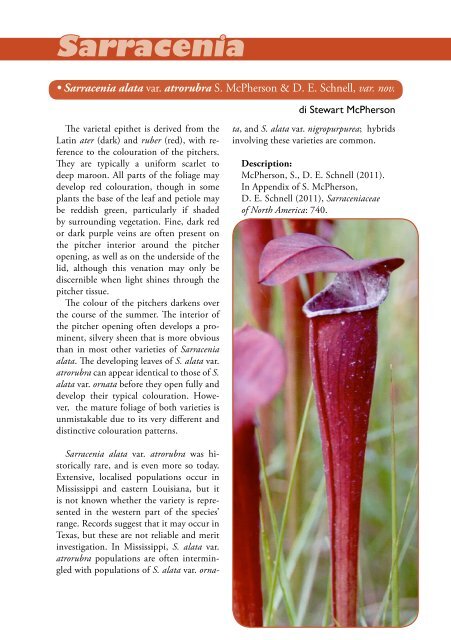SPECIAL ISSUE - Aipc
SPECIAL ISSUE - Aipc
SPECIAL ISSUE - Aipc
Create successful ePaper yourself
Turn your PDF publications into a flip-book with our unique Google optimized e-Paper software.
Sarracenia<br />
• Sarracenia alata var. atrorubra S. McPherson & D. E. Schnell, var. nov.<br />
The varietal epithet is derived from the<br />
Latin ater (dark) and ruber (red), with reference<br />
to the colouration of the pitchers.<br />
They are typically a uniform scarlet to<br />
deep maroon. All parts of the foliage may<br />
develop red colouration, though in some<br />
plants the base of the leaf and petiole may<br />
be reddish green, particularly if shaded<br />
by surrounding vegetation. Fine, dark red<br />
or dark purple veins are often present on<br />
the pitcher interior around the pitcher<br />
opening, as well as on the underside of the<br />
lid, although this venation may only be<br />
discernible when light shines through the<br />
pitcher tissue.<br />
The colour of the pitchers darkens over<br />
the course of the summer. The interior of<br />
the pitcher opening often develops a prominent,<br />
silvery sheen that is more obvious<br />
than in most other varieties of Sarracenia<br />
alata. The developing leaves of S. alata var.<br />
atrorubra can appear identical to those of S.<br />
alata var. ornata before they open fully and<br />
develop their typical colouration. However,<br />
the mature foliage of both varieties is<br />
unmistakable due to its very different and<br />
distinctive colouration patterns.<br />
Sarracenia alata var. atrorubra was historically<br />
rare, and is even more so today.<br />
Extensive, localised populations occur in<br />
Mississippi and eastern Louisiana, but it<br />
is not known whether the variety is represented<br />
in the western part of the species’<br />
range. Records suggest that it may occur in<br />
Texas, but these are not reliable and merit<br />
investigation. In Mississippi, S. alata var.<br />
atrorubra populations are often intermingled<br />
with populations of S. alata var. orna-<br />
di Stewart McPherson<br />
ta, and S. alata var. nigropurpurea; hybrids<br />
involving these varieties are common.<br />
Description:<br />
McPherson, S., D. E. Schnell (2011).<br />
In Appendix of S. McPherson,<br />
D. E. Schnell (2011), Sarraceniaceae<br />
of North America: 740.<br />
29 - AIPC Special Issue n. 4


